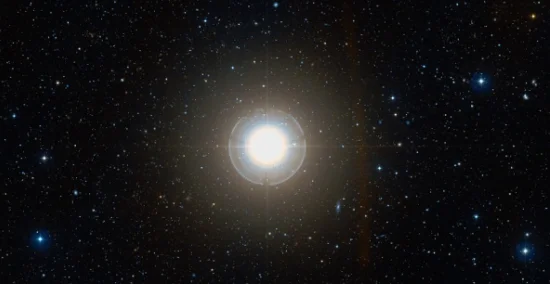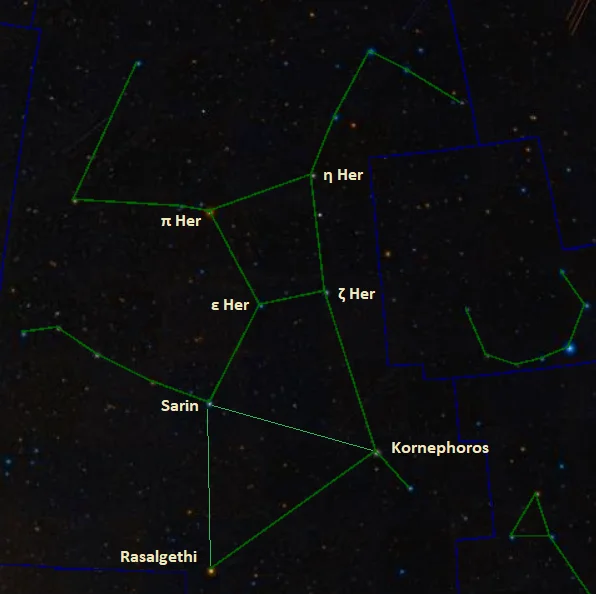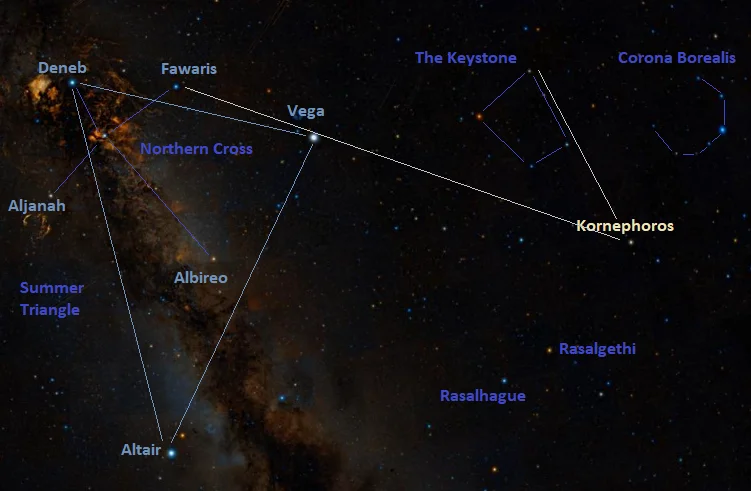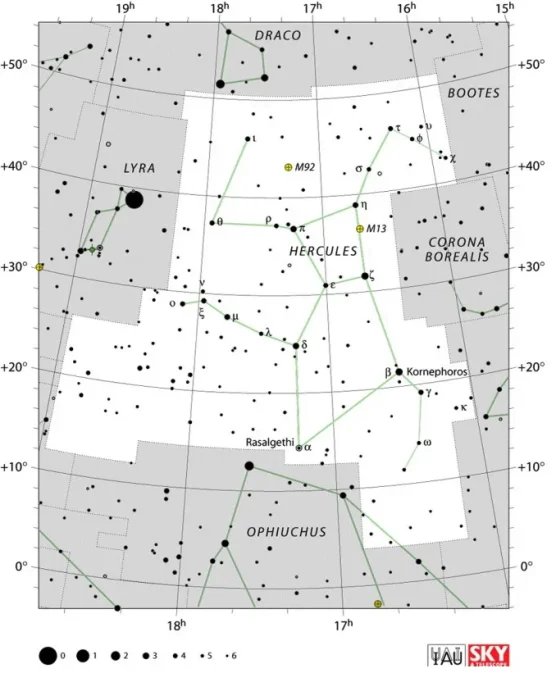Kornephoros, Beta Herculis (β Her), is a luminous yellow giant star located in the constellation Hercules. With an apparent magnitude of 2.81, it is the brightest star in the constellation. It is part of a binary system located at a distance of 139 light years from Earth.
Star system
Beta Herculis is a binary star system consisting of Kornephoros, a yellow giant of the spectral type G7 IIIa, and a close companion. Kornephoros has a mass 2.9 times that of the Sun and a radius 17 times solar. With a surface temperature of 4,887 K, it is 151 times more luminous than the Sun. The star is a relatively slow spinner, with a projected rotational velocity of 3.0 km/s. It is a suspected variable star. Its brightness has been reported to rise as high as magnitude 2.76.
Kornephoros has stopped fusing hydrogen in its core and has begun to evolve rapidly as it left the main sequence. It is not massive enough to meet its end as a supernova. When it comes to the end of its life cycle, it will expel its outer layers to form a planetary nebula and gradually fade away as a white dwarf.
The companion is considerably less massive, with 0.9 solar masses. The two stars orbit each other with a period of 410.6 days and a high eccentricity of 0.55. The system’s orbital plane is inclined 53.8° to our line of sight.

Kornephoros (Beta Herculis), image: Wikisky
Facts
In Arabic astronomy, Kornephoros was part of an asterism known as the Northern Line (al-Nasaq al-Shāmī) of the Two Lines (al-Nasaqān). The other stars that formed the asterism were Gamma Herculis, Gamma Serpentis and Beta Serpentis.
The Beta Herculis system appears as a single star to the unaided eye. Its binary nature was discovered by the American astronomer W. W. Campbell in July 1899. Campbell found variations in the star’s radial velocity, indicating the presence of a companion.
The system was resolved using speckle interferometry with the 200-inch Hale Telescope at Palomar Observatory in 1977. The team that conducted the observations found that the system was a spectroscopic binary, that the two components were separated by 43 ± 4 milliarcseconds, and that the companion was red. The orbital elements were computed in 2005 using spectroscopic data and data collected by the Hipparcos satellite.
Name
The name Kornephoros (pronunciation: /kɔːrˈnɛfərəs/) is Greek for “club bearer,” referring to Hercules. It was once used for the entire constellation.
The name was approved by the International Astronomical Union’s (IAU) Working Group on Star Names (WGSN) on August 21, 2016. It formally applies only to the primary component of the Beta Herculis system.
Beta Herculis has also traditionally been known as Rutilicus, which is a corruption of the Latin titillicus (“armpit”). The name refers to the star’s position in Hercules, marking the hero’s armpit or shoulder.

Hercules stars, image: Wikisky
The Chinese know Kornephoros as 天市右垣一 (Tiān Shì Zuǒ Yòu yī), the First Star of Right Wall of Heavenly Market Enclosure. In Chinese astronomy, the star is part of an asterism known as Right Wall of Heavenly Market Enclosure, along with Gamma Herculis, Marsic (Kappa Herculis), Gamma Serpentis, Beta Serpentis, Delta Serpentis, Unukalhai (Alpha Serpentis), Epsilon Serpentis, Yed Prior (Delta Ophiuchi), Yed Posterior (Epsilon Ophiuchi), and Zeta Ophiuchi. The asterism is part of the Heavenly Market Enclosure, which represents the emperor’s realm. The stars of the Right Wall represent 11 cities and Kornephoros represents the historical Hezhong Prefecture.
Location
Kornephoros is not too difficult to find because it lies near several prominent asterisms: the Northern Cross in Cygnus, the Keystone in Hercules, and Ariadne’s Crown in Corona Borealis. The Keystone is the faintest of the three patterns but is easily made out on a clear night. It is formed by four relatively bright stars: Pi, Eta, Zeta and Epsilon Herculis. Kornephoros is found on an imaginary line drawn from Eta through Zeta Herculis.
Alternatively, it can be located by extending a line from Fawaris at the wing of Cygnus through the bright Vega in Lyra. It is the brightest star along this imaginary line.

Kornephoros location, image: Wikisky
Constellation
Kornephoros is the luminary of the constellation Hercules. Hercules is the second largest northern constellation, after Ursa Major, and the fifth largest of all 88 constellations. It occupies an area of 1,225 square degrees of the northern sky. Representing the Roman equivalent of the mythical Greek hero, Hercules is one of the 48 Greek constellations, first catalogued by the Greek astronomer Claudius Ptolemy in his Almagest in the 2nd century CE.

Hercules constellation map by IAU and Sky&Telescope magazine
Even though it is large, Hercules is not particularly prominent in the sky, with only two stars brighter than magnitude 3.00: Kornephoros and Zeta Herculis. However, the constellation is easily recognizable for the Keystone asterism, formed by its four relatively bright stars: Pi, Eta, Epsilon and Zeta Herculis. The Keystone outlines the torso of the Greek hero.
Hercules is best known for its two bright globular cluster, Messier 13 (the Hercules Globular Cluster) and Messier 92. Found between Eta and Zeta Herculis, the Hercules Globular Cluster is the brightest globular cluster in the northern celestial hemisphere. With an apparent magnitude of 5.8 and an apparent size of 20 arcminutes, it is visible without binoculars on a clear, dark night. Messier 92, which forms a triangle with the Keystone stars Pi and Eta Herculis, appears slightly fainter and smaller with an apparent magnitude of 6.3 and an apparent size of 14 arcminutes.
Hercules also hosts the relatively bright (mag. 9.4) globular cluster NGC 6229, the planetary nebulae NGC 6210 (the Turtle Nebula, mag. 12.66) and Abell 39 (mag. 13.7), and the Hercules Cluster of galaxies (Abell 2151), a large grouping of about 200 galaxies located approximately 500 million light years away.
The best time of year to observe the stars and deep sky objects of Hercules is during the month of July, when the constellation rises high in the evening sky. The entire constellation is visible from locations between the latitudes 90° N and 50° S.
The 10 brightest stars in Hercules are Kornephoros (Beta Her, mag. 2.78), Zeta Herculis (mag. 2.81), Sarin (Delta Her, mag. 3.126), Pi Herculis (mag. 3.15), Rasalgethi (Alpha Her, mag. 3.350), Mu Herculis (mag. 3.417), Eta Herculis (mag. 3.487), Xi Herculis (mag. 3.70), Gamma Herculis (mag. 3.75), and Iota Herculis (mag. 3.80).
Kornephoros – Beta Herculis
| Spectral class | G7 IIIa |
| U-B colour index | +0.70 |
| B-V colour index | +0.91 |
| R-I colour index | +0.47 |
| Apparent magnitude | 2.81 |
| Absolute magnitude | −0.49 ± 0.10 |
| Distance | 139 ± 3 light years (43 ± 1 parsecs) |
| Parallax | 23.44 ± 0.58 mas |
| Radial velocity | -25.91 ± 0.54 km/s |
| Proper motion | RA: -99.15 ± 0.37 mas/yr |
| Dec.: -15.39 ± 0.50 mas/yr | |
| Mass (β Her A, β Her B) | 2.9 M☉, 0.9 M☉ |
| Luminosity | 151 L☉ |
| Radius | 17 R☉ |
| Temperature | 4,887 K |
| Metallicity | -0.27 dex |
| Rotational velocity | 3.0 km/s |
| Surface gravity | 2.5 cgs |
| Constellation | Hercules |
| Right ascension | 16h 30m 13.1995466s |
| Declination | +21° 29′ 22.600778″ |
| Names and designations | Kornephoros, Rutilicus, Beta Herculis, β Her, 27 Herculis, HD 148856, HR 6148, HIP 80816, SAO 84411, FK5 618, PPM 104935, BD+21 2934, AG+21 1607, GC 22193, GCRV 9493, JP11 2768, PLX 3754, IRAS 16280+2135, 2MASS J16301319+2129225, TYC 1518-1442-1, UBV 13963, WDS 16302+2129A/Aa, WDS J16302+2129Aa,Ab, CCDM J16302+2129A, IDS 16260+2142 A |